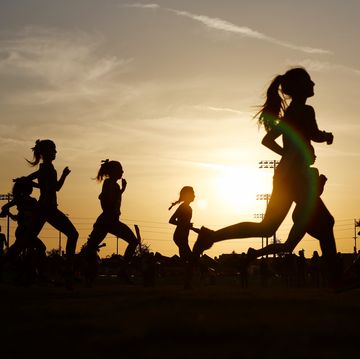I have a confession. In nearly 18 years of racing, I have never run a Rock ’n’ Roll event. That seems almost blasphemous these days, don’t you think? I mean, they are ubiquitous and there’s even one in nearby Washington, D.C., which would make it convenient for me. But that’s just it. It wouldn’t be convenient. I’m not opposed to the Rock ’n’ Roll brand by any stretch of the imagination. But for the most part, I am opposed to huge, crowded races.
With a few exceptions over the years—the Boston Marathon, the Cherry Blossom and Broad Street 10-milers among them—I have raced mostly local and mostly smaller. Now, I know the large events are fun. Who doesn’t love the confetti, the bands, the crowds, the whole pomp and circumstance of the big guns? And the swag. Tiffany necklace anyone? I can totally understand how runners are drawn to these races, especially first-time marathoners who can use the extra energy that crowds provide in the later miles. Being surrounded by lots of fellow athletes, appreciative spectators, and lots of distractions definitely works for many folks.
But back to that convenience thing. Big races are anything but as you set an alarm for 3:30 a.m. to toe the line at 8. There are the long porta-potty lines, the parking hassles, and the throngs of people through which you must maneuver to line up. It may be 10 minutes before you even cross a starting mat and elbow room will never be available, even in the later miles.
Give me the smaller race any day of the week. To begin with, it usually means sleeping in my own bed, rolling out of said bed only an hour or two before the start time, and sliding right into a parking spot, easy peasy.
Looking around at the starting line—no corrals needed, by the way—and I’ll spot lots of familiar, friendly faces. Dennis Albright, who is the RD for the Columbia, Maryland-based Clyde’s 10K, which draws about 1,800 runners each year, says there’s much to appreciate in a smaller event. “You get a friendlier atmosphere, lower race fees, and a convenient event,” he points out.
Because of that convenience, it won’t swallow up your entire day, either. At a smaller, local event, I can run, grab postrace food, shower, and be on the sidelines of my kids’ soccer games by noon.
Lee Corrigan, owner of event organizer Corrigan Sports, manages both large and small events in Maryland and California, ranging in size from 1,000 to 27,000 people (the Baltimore Running Festival). He says that an added bonus to smaller events is that they are often tied in to local charities. “We have the Brigance Brigade, for instance,” he explains. “It benefits the Brigance Brigade Foundation which helps people with ALS disease and honors Baltimore Ravens player O.J. Brigance. People get behind an event like this because they are helping a good cause and rallying around a local hero.”
I agree. Over the years, my local racing fees have helped myriad causes—from homeless shelters to disease foundations and scholarship funds. It feels good to support these organizations, as well as the local economy.
Yes, you give up the top-notch premium, the crowd support, and bells and whistles when you race smaller events. But in my opinion, you gain so much more!













